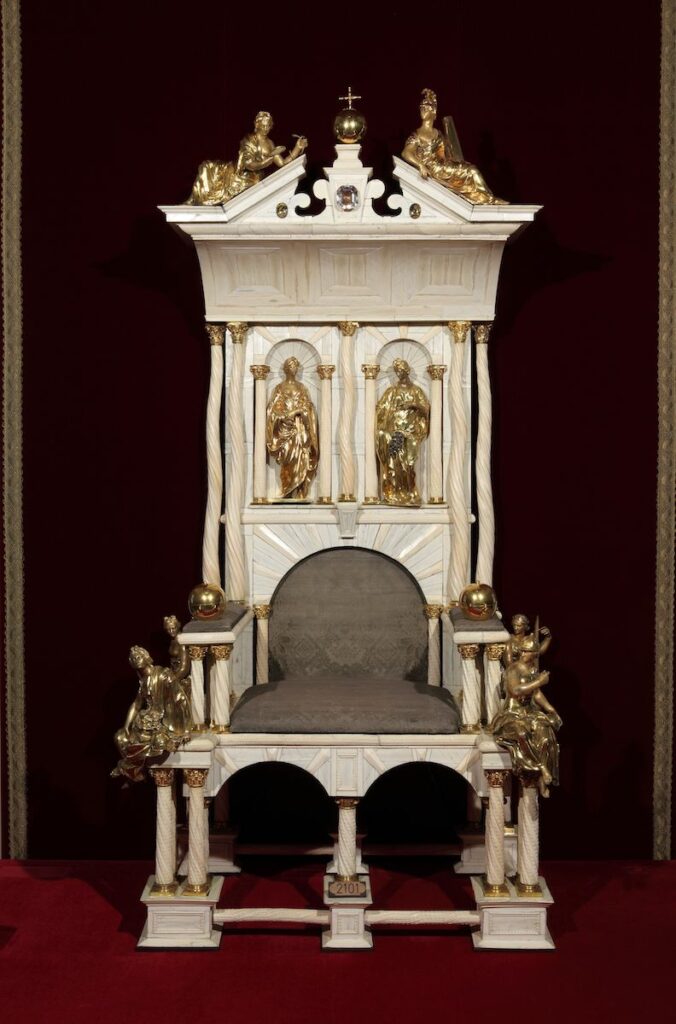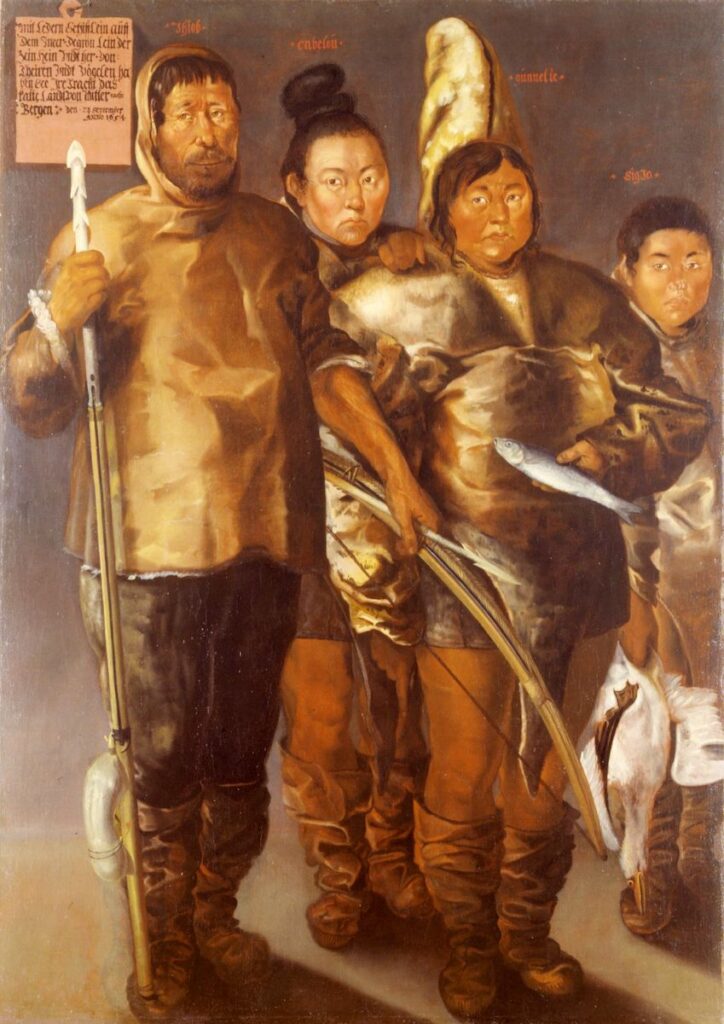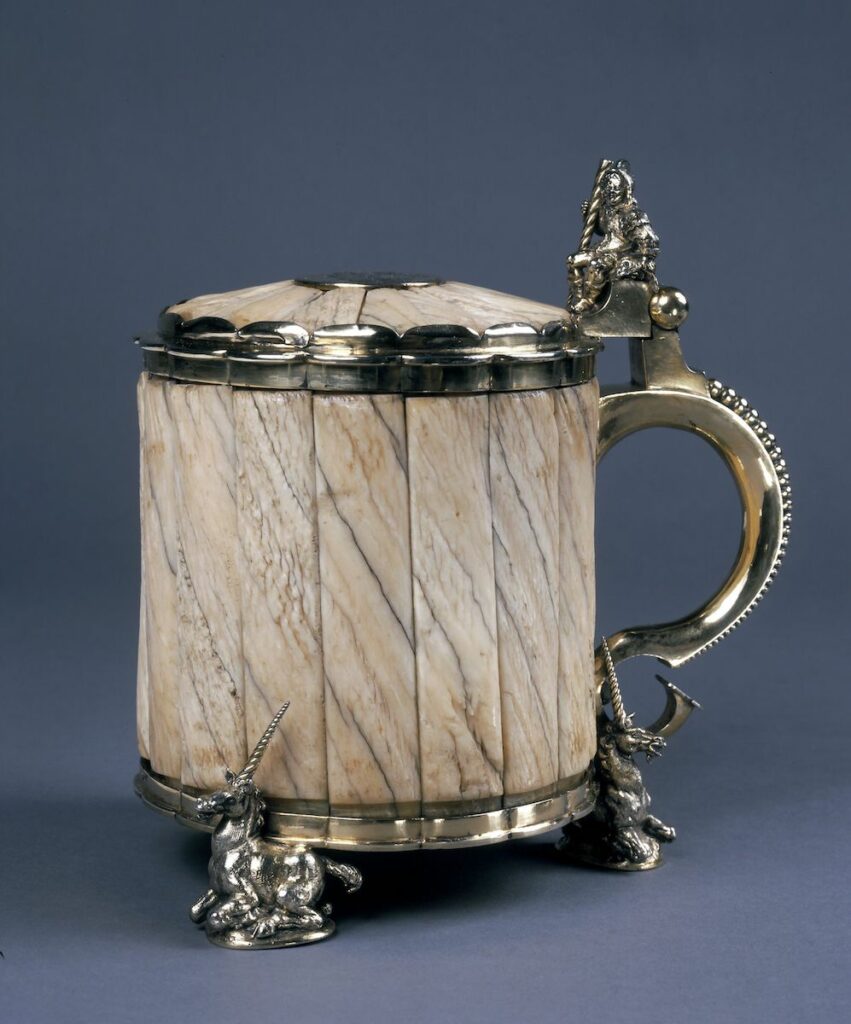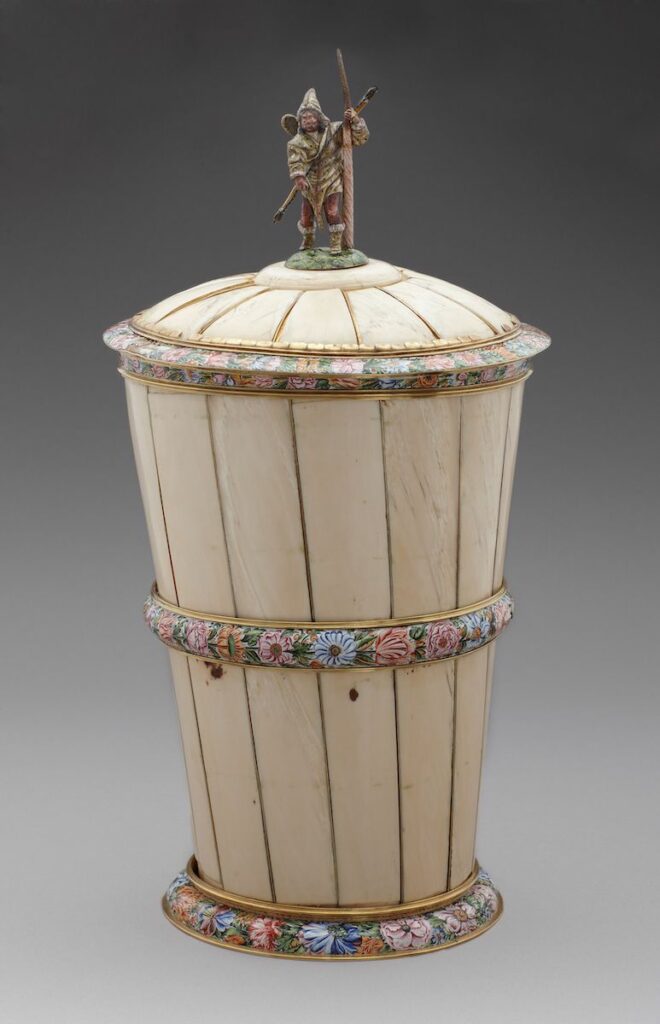Kaitlin Grimes
As the official coronation chair of the Oldenburg monarchy, the Anointment Chair of Absolutism sits regally at the end of a grand hall at Rosenborg Castle in Copenhagen, surrounded with rich tapestries, sumptuous velvets, and opulently ornamented walls and ceilings (Fig. 1). Attributed to Bendix I Grodtschilling (1620–1690), its twisted and spiralized cream ivory juxtaposes with the gleaming gold ornamentation placed strategically around the throne. Although the bleached whiteness of the ivory suggests that it derives from elephants, the throne is actually constructed from narwhal tusk, the “territorial speciality” of Denmark-Norway and a product of the kingdom’s Arctic colonies.

As a mammal native to the cold waters of the Far North, the narwhal (Monodon monoceros, or qilalugaq qernertaq in the Greenlandic language) is an intriguing creature desired throughout history for its physical characteristics. Narwhal were integral to indigenous Inuit culture in colonized Greenland (Kalallit Nunaat). Denmark capitalized on their economic and trade monopolies within the Arctic, including Greenland, to colonize and usurp narwhal ivory for its monarchical use. This short essay looks at three significant uses of narwhal ivory within Denmark as a monarchical material and as a materialization of Scandinavian colonization of the Arctic. Through an analysis of the narwhal within the High Arctic and Denmark’s reconceptualization of the mammal’s parts, I illustrate how objects made from narwhal ivory aimed to assert the political and colonial strength of the Danish over the Arctic. Furthermore, I explicate how narwhal ivory produced a form of “cold art,” to borrow Christopher Heuer’s term, which materially recalled the “exotic barrenness” of the Arctic landscape and Danish control over it.[1] The material’s status as the territorial speciality of the state suggests the Arctic’s indelible role in the production of Denmark as a cultural space and colonial power in the early modern world.
Denmark’s coloniality began long before that of many other European nations. In 1380, King Olaf II (1370–1387) united Denmark and Norway in a personal union that brought several other small island territories under Danish protection, including the Faroe Islands, Iceland, and Greenland, which the monarchy maintained strict control over for centuries. In 1636, King Christian IV established a trade monopoly over Greenland, which was given to a Copenhagen-based trading company in order to maintain Danish sovereignty.[2] As Denmark’s northern colonial base grew, the Oldenburg monarchs sent naval expeditions to the Arctic colonies, such as Christian IV’s 1605–1607 journey, which brought back numerous narwhal tusks. As Daniel Dannel noted in his personal accounts during his return expedition in 1653, he “weighed the unicorn [narwhal] they had obtained, consisting of eight complete horns, a small young one, all nine complete to their points and weighing in all 88 ½ pounds.”[3]
The Arctic was unlike anything Europeans had encountered in their other colonial endeavors. In stunning dichotomy to the lush, vegetal sites of the New World, the Arctic was barren, vast, abstract, unknowable, and seemingly void.[4] The blinding white sheets of ice in the polar summer against its utter darkness in the winter illustrated an inhospitable landscape completely unfamiliar to colonial explorers. As one anonymous Danish sailor stated in 1607, “we could never see.”[5] The Arctic became a complicated need for Europe: it was a paradoxically blank space that was nonetheless ripe for global traversing and for extracting resources.
Narwhal tusk became a major material element in Danish court life and developed into a metonymic materialization of the Oldenburg’s colonization efforts, and this incarnation is manifested in Grodtschilling’s throne. The use of narwhal ivory to construct the literal seat of monarchical power was not merely coincidental; the stark colonial power of the material allowed for the throne to illustrate the expansion of the kingdom as well as the power and might of its ruler. Through the narwhal’s relationship to the Arctic, the throne physically embodied Danish control, exploitation, and material manipulation of the cold.
While narwhal ivory played an indelible role in the materialization of Danish prowess, the narwhal has a much more entangled history within Inuit culture. According to Inuit legend, the narwhal was once a long-haired woman. Her blind and abused son (or stepson, in some tellings) grew tired of her abuse and tied her to the end of his harpoon, which he then launched into a white whale passing by the shore. The whale dragged the woman into the frigid Arctic waters. Her long hair, twisting and entwining in the turbulent cold waters, became the tusk of the Arctic mammal.[6] Throughout their history, Inuit social practices have utilized narwhal for a variety of needs: the meat and skin (muktuk) for food, the blubber as a heat source, and ivory for small artistic objects. While Inuit people utilized many Arctic faunas, the narwhal held special significance to them. As James Deutsch has surmised, the narwhal “…as a former human being living in the Arctic,” linked sea and land, human and beast.[7] Since the narwhal flourished in frigid Arctic waters, Inuit mythology causally links the narwhal to the coldness of northern waters; the narwhal could not exist without the Arctic and its temperatures. The Arctic, as an abstracted and detached exotic space, directly opposed commonplace European understandings of otherness. Unlike the hot climates of the Americas and Africa, the Arctic was continuously and intensely cold, and it was this cold that produced the narwhal.

Like the relationship between elephant ivory and enslaved Africans, commodified together in patterns of early modern economic exchange, narwhal ivory had similar associations with colonized and kidnapped Inuit people. On the return journey of a 1654 Danish Arctic expedition, the crew docked with three Inuit women (Gabelou, Gunelle, and Sigjo) and one man (Jhiob), whose portrait was immediately painted upon arrival in Bergen, Norway (Fig. 2).[8] While Jhiob died on the voyage back to Copenhagen, the three women became celebrities at the Danish court. The women were so popular, in fact, that Frederik III commissioned favored monarchical ivory artist Jacob Jensen Nordmand to create several narwhal vessels with images of Inuits like them, alongside walruses and narwhals, the trinity of Danish colonial iconography of the Arctic.[9] Unlike the absolutist throne and its almost bleached whiteness, Nordmand’s vessels retain the gray/cream coloration of natural, unrefined narwhal ivory. Here, the intricate groves and striations of the wear-and-tear of narwhal Arctic life are highlighted and celebrated. The inherent roughness and discoloration visually and materially signify these objects as Arctic others, vastly different from the hundreds of elephant ivory objects in the same collection spaces.

Nordmand’s narwhal vessels date from the mid-1650s to the early 1660s, like the Lidded Tankard with Inuit (Greenlanders) and Unicorns (Fig. 3). In a striking material juxtaposition to the narwhal horn, silver is added as the footing, base rim, handle, and upper rim, and this offsets and magnifies the narwhal’s material qualities. Surrounded by sectioned ornamentation is a central medallion depicting two Inuit: a woman on the left and a man on the right carrying a bow and arrow in his right hand and a harpoon in his left. Art Historian Mogens Bencard has argued that the two figures represent Jhiob and Gunelle, with their images taken from the Bergen portrait.[10] The bearded man in the portrait wears a similar style tunic with a hood, loose-fitting pants, and slouched boots; the female in the cup’s medallion, however, does not directly match the portrait, although there are shared characteristics between the painted women and the medallion.

Continuing the Danish visual proclamation of Arctic colonization, Nordmand fashioned a second lidded vessel with Inuit iconography. In Lidded Beaker with Inuk (Greenlander), Nordmand utilized the same vertical sectioning as the previous narwhal vessel and similar enameled ornamentation, adding a colorful and decorative element for royal enjoyment (Fig. 4). The lid continues the narwhal stave patterning with an enameled copper Inuk hunter dynamically walking as the finial. In his left hand, the man carries a stylized narwhal tusk while pointing to the enameled green ground under his feet with his right hand. Nordmand included a bow strapped across the man’s back that crisscrosses his quiver of arrows, highlighting the man’s role as a hunter.
At first glance, the man appears to be dressed in appropriate contemporary Inuit clothing, but Nordmand actually costumes the Inuk man as a woman. He wears the same tall, conical hood adorning the head of the central woman in the Bergen portrait as well as the long-pointed strip of fabric in front of her genitals. This misappropriation of male and female clothing presents interpreters with a conundrum since Inuit clothing styles had been described in pictures, scientific writings, and travel accounts for centuries. Famously, Adam Olearius, a German mathematician, wrote about Inuit clothing styles in his Vermehrte Newe Der Muscowitischen und Persischen Reyes from 1656, with a section dedicated to “Greenland.” He stated, “the hood of the men sits flat on top of the head while that of the women extends almost half an ell above the head because of their hair arrangement. The female coat has a long point hanging from it in front and at the back, extending all the way down to the knees, something men do not have.”[11]
On the interior of the lid, directly under the man, Nordmand placed a round enamel medallion encased in gold depicting King Frederik III’s monogram (“FRIDERICUS 3”) topped with an ornate gold crown. The anonymous enamel artist also included the date, 1663, spread out to both sides of the crown. Underneath this date, the words “DOMINUS” and “PROVIDEBIT” appear (“The Lord Will Provide”), completing the divinely ordained Danish colonial cycle for the absolutist Oldenburg monarchy. Jørgen Hein argued that “The Greenlander on the cover makes the beaker a symbol of the Danish king’s supremacy over the northern seas.”[12] I concur with Hein’s assertion that this cup visually referenced the monarchy’s growing control over the Arctic waters but wish to take this idea further. It was not only the imagery of the Inuk man that alerted viewers to the cup’s symbolism, but also the material of narwhal ivory that visually and materially connected Denmark to the Arctic empire. The inclusion of the man as a hunter offers an intriguing juxtaposition: the narwhal hunter becomes the prey of the bigger hunter, Denmark. The colonial hunter usurps the colonized indigenous population and their traditions, like the hunting of narwhal, for the colonizer’s pleasure, thereby completing the colonial cycle.
Narwhal became the material of the state through its ability to represent both colonial High-Arctic territories and the absolutist power of the monarchy. This duality, present in the Anointing Chair, promoted the colonialist agenda and the absolutist political agenda domestically. Projecting an interwoven and intersected Danish colonial world, the utilization of the narwhal materially strengthened and codified colonialist power for visual pleasure at home. The Danish crown utilized narwhal specifically to exclaim its personal and integral knowledge of the Arctic and its innate ability (through Norse heritage) to use, tame, exploit, and metamorphosize the Arctic and its products. Unlike other European colonial powers who attempted to control the Atlantic, the Danes became the tamers of the cold. The throne expertly marks Danish subordination and capture of the Far North.
When comparing the throne to Nordmand’s vessels, distinct material narratives of Danish power emerge. In Oldenburg royal coronations, the soon-to-be king sat upon the throne, clutching the ivory arms, and only then received his divinely ordained authority as king. Throughout the ceremony, narwhal surrounded the king, encompassing the monarch within combined spheres of Arctic materiality and kingly power. It is only when the king sits upon it that the throne becomes activated, warmed by his body and thereby transformed. This is a parallel set of sensual associations to the Arctic under Danish control.
Nordmand’s narwhal vessels operate in a similar manner but highlight the colonial exploitation of the Inuit and the Arctic more clearly. Unlike the throne, these vessels did not have a specified function; they were created as cabinet works or decorative objects meant to be enjoyed as curiosities. Nordmand’s vessels present the Inuit origination of the material and illustrate Arctic colonization of the people and their land and waters. Furthermore, the enameled narwhal hunter, holding a tusk, placed atop a vessel created for elite consumption, illustrates the monarchy’s usurpation of the material and its metamorphosis from a traditional Inuit product into a monarchical statement.
Both vessels are opened through the act of holding or pressing upon an Inuk man, and each act of opening these vessels continues the colonization and domination of the peoples and products of the Arctic, here presented metaphorically through the objects. On the Lidded Tankard, Nordmand included a silver Inuk man holding a tusk who acts as the hinged thumbpiece that opens the lid. The user’s (colonial) finger must stay pressed against this silver Inuk man in order to drink or keep the lid open. In the Lidded Beaker, the viewer must physically wrap their hand fully around the Inuk hunter to open the vessel. In each case, the colonial hand engages tactilely with Arctic otherness and presents a performative reminder of the Arctic’s relationship to Denmark.
One could then say that these small and seemingly innocuous vessels, decorated with colonial iconography, actually convey the political and colonial strength of the Danish kingdom. The material’s demarcation as the “territorial speciality” of the state generated material sensations that recalled the absolutist supremacy of Denmark over the north. The narwhal tankards visually and materially unite the narwhal throne of the Danish monarchy, the tangible territories of the kingdom, and its colonized people.
Kaitlin Grimes is a Visiting Assistant Professor of Art History at Auburn University in Auburn, Alabama
[1] Christopher Heuer, Into the White: The Renaissance Arctic and the End of the Image (New York: Zone Books, 2019), 60.
[2] Knud Jespersen, A History of Denmark, trans. Ivan Hill and Christopher Wade (London: Springer Nature Ltd., 2004), 22.
[3]J. Erichsen, Udtog af Chr. Lunds Indberetning til Kong Frederik III af 28 Martii 1664… (Copenhagen, 1787), 35. Quote taken from Mogens Bencard, “Two 17th-Century Eskimos at Rosenborg Palace,” in The Mummies from Qilakitsoq: Eskimos in the Fifteenth Century, eds. J. P. Hart Hansen and H. C. Gulløv (Copenhagen: Meddelelser om Grønland, 1989), 47–55.
[4] Heuer, Into the White, 35.
[5] C. C. A. Gosch, Danish Arctic Expeditions, 1605 to 1620, In Two Books (London: Hakluyt Society, 1897), 1:30. Quote taken from Heuer, Into the White, 12.
[6]James Deutsch, “How the Narwhal Got Its Tusk,” Smithsonian Magazine, online, last modified August 7, 2017, https://www.smithsonianmag.com/smithsonian-institution/how-narwhal-got-its-tusk-180964331/ (accessed September 19, 2023).
[7] Deutsch, “How the Narhwal.”
[8] Bencard, “Eskimos,” 50.
[9] Jørgen Hein, Ivories and Narwhal Tusks at Rosenborg Castle: Catalog of Carved and Turned Ivories and Narwhal Tusks in the Royal Danish Collection, 1600–1875 (Copenhagen: Museum Tusculanum Press, 2018), 20.
[10] Bencard, “Two 17th-Century Eskimos at Rosenborg Castle,” 50.
[11] Adam Olearius, Vermehrte Newe Beschreibung der Muscowitischen und Perischen Reyse, (Schleßwig: Holwein, 1656). Quoted in Bencard, “Eskimos,” 53.
[12] Hein, Ivories and Narwhal Tusks, 57.
Cite this article as: Kaitlin Grimes, “Narwhal Ivory as the Arctic Colonial Speciality of the Kingdom of Denmark-Norway,” Journal18, Issue 16 Cold (Fall 2023), https://www.journal18.org/6983.
Licence: CC BY-NC
Journal18 is published under a Creative Commons CC BY-NC International 4.0 license. Use of any content published in Journal18 must be for non-commercial purposes and appropriate credit must be given to the author of the content. Details for appropriate citation appear above.
